 |
||||
A Year of Hoverflies
What to see and do month by month...
January
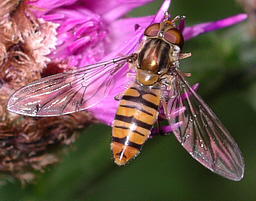 Episyrphus balteatus
Episyrphus balteatus
Although this is the coldest month of the year, it is certainly still possible to see hoverflies in Bedfordshire. Very conveniently for us, one of the best places to look is around buildings and in gardens. South-facing walls are always worth checking on sunny days, even when the air temperature is low. Amidst the basking bluebottles and other species, the honeybee-mimicking Drone-fly Eristalis tenax should stand out by its rather glossy appearance. Don't be deceived by the threatening pulsating abdomen, there is no sting involved here, just marvellous mimicry of insects that do possess one. Any blossom out now (for instance of viburnum or winter jasmine) will also attract tenax, as well as the few other species that overwinter as adults. Look out for the Marmalade Hoverfly Episyrphus balteatus, with the distinctive double bands on its abdomen
This is a good time to make records of the less-commonly overwintering species: in Bedfordshire in recent years, they have included the slender Meliscaeva auricollis (with broad blackish "arrowheads" pointing up the centre of its grey-brown abdomen) and the chunky Scaeva selenitica (with u-shaped pale yellow crescents on a black background). Why not jot down what you find in your diary, or better still a dedicated notebook? You can then compare your results (with those of other observers if you wish) in this and future seasons. Quite apart from their intrinsic value, such records can potentially provide a useful measure of the rate of change in our climate, as warmer winters allow more species to survive.
February
Winter wears on, and as we at last notice the days beginning to lengthen, it's worth continuing to check sheltered spots and any flowers or blossom to be found. The likeliest hoverfly species to be present continues to be the Drone-fly – a "lazy honeybee" that shines in the winter sun. The Marmalade Hoverfly should also still be in evidence on sunny days. In summer, individuals of this species tend to be bright yellow or orange, but now they may show much darker colours - including attractive blues - which are a result of cold temperatures during the development of the young insect. Any other hoverfly species seen will definitely be worthy of special note. Pay particular attention to the pattern of spots or bars you can see on the abdomen. These are key identification marks at any time of the year, but may well be unique in the field now, when there are few species about to confuse matters.
Even if there are no flies to be seen, time spent outdoors can still be put to good use in their study. For instance, this is a good month to take note of sheltered blackthorn bushes, large clumps of ivy, trees with discolorations caused by flowing sap, and lines of horse chestnut trees in suburban areas. In later months, some good hoverflies may be found in these places, as we will see. If the weather is grim, this is a great time to do some homework. Committing to memory a few basic details about the structure of hoverflies, and the broad groups into which they fall, will do wonders in helping you make sense of the different species when you are busy with them in a few weeks time. What better occupation for the naturalist who needs a good excuse not to venture out into the rain and cold!
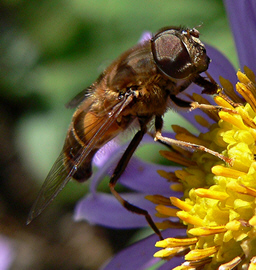 Eristalis pertinax
Eristalis pertinax
March
This is the crossover month, for hoverflies as for many other creatures in our county. In the first two weeks or so, the only species in evidence are likely to be those that have survived the winter as adults.
But when the first days of true spring arrive, they are joined by newcomers that have just emerged as fresh adults. The earliest of these may well be Eristalis pertinax, a close relative of the Drone-fly. It is about the same size, but with obvious pale areas on slimmer hind legs, and with distinctive pale front feet. As a powerful hoverer, the first sighting may be of a male, several feet up, staking out a territory in some sheltered corner of the garden. When he lands, the abdomen looks rather cone-shaped or pointed, unlike the blunter Drone-fly.
Willow and hazel catkins provide a welcome early supply of food for several species, including in the genus Syrphus. You will need good, often captive, views to distinguish between the three common species in the genus, and many records will have to go down as Syrphus sp.
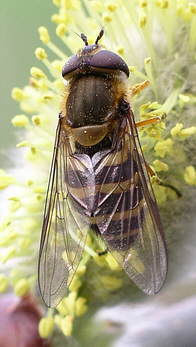 Syrphus sp.
Syrphus sp.
April
It can be hard to believe when the showers are falling, but there are a number of insect species that favour this month especially. The secret to seeing early spring hoverflies is to find sheltered places with a supply of food, and to be there when the sun is out, even if that happens only briefly. One of the most productive places to be is in front of a blossoming blackthorn bush. If the wind is blowing, choose bushes well protected from it, perhaps along a ride in a wood. Among the hoverflies that especially like blackthorn, a striking species is the first bumblebee mimic of the year, Criorhina ranunculi. This large and furry black hoverfly occurs in both red-tailed and white-tailed forms. Quite a contrast is provided by the two sexes in the uncommon small species Melangyna quadrimaculata: the male has an unusual pattern of four small spots on the abdomen, and the female is all dark. Other species that love blackthorn include the large-spotted Parasyrphus punctulatus (which may be very numerous around the blossom), and Epistrophe eligans, a slim, but particularly bright and shiny mimic of a honeybee.
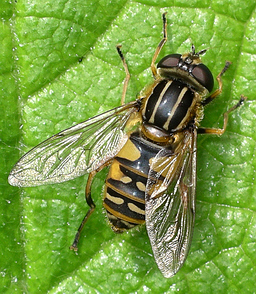 Helophilus pendulus
Helophilus pendulus
April is a good time to check the latest publications, or this website, for BNHS events, and make plans to come along. You will have the chance to contribute and to learn about hoverflies and very much else besides.
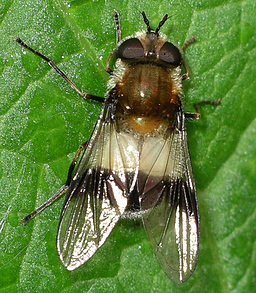 Leucozona lucorum
Leucozona lucorum
May
Things are really starting to buzz! Near the beginning of the month, several species of hoverfly will appear for the first time in the year. Among them is the very handsome Leucozona lucorum, with a foxy-red thorax, black and white abdomen and jet-black wing patches. It can be found in many habitats, from woodlands to gardens, and is hard to confuse with anything else. In the hedgerows, hawthorn blossom takes over from blackthorn, and is equally as rich in interesting hoverfly species. This month, too, the bluebell woods should be looking their best - but not every bulb will have produced a flower. Instead, something very different may have emerged, in the shape of an adult Merodon equestris - the Large or Greater Bulb-fly. Domesticated bulbs are not immune, and the gardeners among you may well see this species if you have cultivated Narcissi, for instance. Forgive it if you can, for it is both attractive to look at, and very entertaining. It is a bumblebee mimic and comes in several colour forms from black to buff, often with broad black bands. It is great fun to watch the males zooming along the flower beds and deliberately ramming each other - or even bumblebees - in what is presumably territorial behaviour.
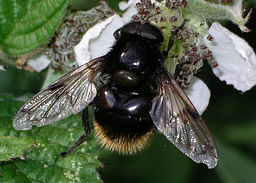 Volucella bombylans
Volucella bombylans
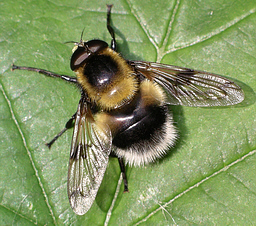 Volucella bombylans var. plumata
Volucella bombylans var. plumata
Another bee mimic is on the wing now, but one with a very different life history. Volucella bombylans grows up in the nests of bees and wasps, scavenging on waste, perhaps even feeding on the young brood, and somehow emerging unstung. In southern England, the adults come in two colour forms, one black with a red tail, and one black and yellow, with a white tail. They look remarkably like bumblebees, but of course have just two wings (which are also well marked with black), and they spend more time sitting quietly than any bee. They are common in many habitats, and often come into gardens.
However, to see the next species, you will need to go to a wood - and not just any wood. At the end of the month, the wild garlic or Ramsons is in flower in some of Bedfordshire's woods, and with it you should find a real specialist hoverfly, Portevinia maculata, the larvae of which feed on the bulbs of this plant and nothing else. The adults are very distinctive, black with rather faint greyish spots in pairs on the abdomen, and bright orange antennae. There is nothing else like them in the British Isles, but on the continent there is a species of Cheilosia which looks very similar, and also feeds on Ramsons. What can be going on there?
June
This is the best month of the year for hoverflies in all their great variety. For the enthusiast, there will not be enough hours, even in these long days, to see all that there is to be seen. As in all fields of natural history, however, anyone can make interesting observations, and here are a few special things to look out for this month. If, earlier in the year, you noted horse chestnut trees in suburban areas, now is the time to revisit them to look for one hoverfly in particular. Brachyopa insensilis is not interested in the flowers (which are now over and well on their way to conkerhood), but in the sap running from wounds on the tree, and staining the bark a darker colour. It is in this sap that the fly lays its eggs, and the larvae feed on it. The adult fly is distinctly odd-looking for a hoverfly. Mostly orangey in colouration, and with a grey thorax, it looks rather like some of our less-lovable flies, but a closer inspection shows the clean and non-bristly look of a proper hoverfly. Once thought of as a rural dweller, this species is being noted more and more often in residential streets and town parks, so keep an eye out for it sitting inconspicuously on the chestnut trunks there.
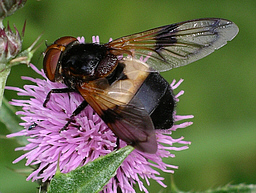 Volucella pellucens
Volucella pellucensIf you fail with sap runs (and they are rather a challenge), you may feel like something a bit easier. If so, try a good-sized patch of bramble, now in flower. Legions of insects are attracted to the blossom, and among the butterflies, beetles and bees, there are almost certain to be hoverflies present. Feeding on a woodland flower or hovering high in a patch of sunlight, may be one of our most distinctive insects, Volucella pellucens, the sun shining through the large white patches on its black abdomen.
July
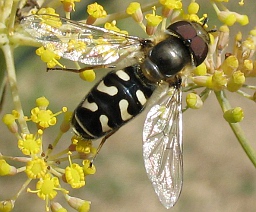 Scaeva pyrastri
Scaeva pyrastri
The hoverfly spectacle continues, with new species continuing to appear on the scene. This is often a good month for Scaeva pyrastri, a large and striking species with broad white, somewhat u-shaped marks on its black abdomen. As the month progresses, if the weather is particularly hot and dry, hoverfly numbers may drop off markedly. Conversely, this is often the month when large gatherings of a few species of hoverfly may be experienced.
The genus Syrphus can be very numerous, with several on a single plant, or even bloom. There are three common species, all rather similar, especially the males. The female Syrphus ribesii is the easiest to distinguish, with hind legs that are entirely yellow, except at the very top. They are probably most people's idea of what a hoverfly should look like, definitely yellow and black, and given to persistent hovering.
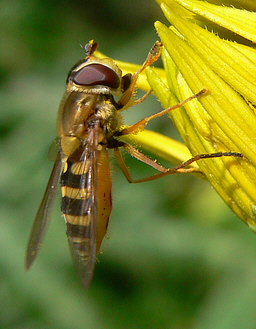 Syrphus ribesii
Syrphus ribesii
August
Large numbers of some species may still be obvious at the beginning of the month, but in the next few weeks the drop in the numbers of species and individuals seen will probably begin to be obvious. By way of compensation, among the late summer hoverflies are some of the most spectacular in Britain - in particular the two large Volucella species. Volucella inanis is somewhat the smaller of the two (about the size of a common wasp, though rather stouter) and bright yellow, with two clear black bands on the upper abdomen. Volucella zonaria is the largest of our hoverflies, approaching the size of a hornet, and clearly mimicking that species, with dark orange and red-brown markings, the brown extending out onto the wings. Both flies come readily into our gardens and can be found, for instance, on Buddleia and ice-plant (Sedum), alongside the bees and butterflies. A few years ago, such things would have been thought impossible in Bedfordshire, with the two species confined to the far south and southeast of England, and the area around London. Now, however, both are expanding their range northwards, and are to be expected in Bedfordshire every summer. If you see either species, check it carefully, make a written note, and pass details to the Recorder or to the national Hoverfly Recording Scheme. In this way, the spread of both species (which may be linked to climate change) can be usefully monitored.
September
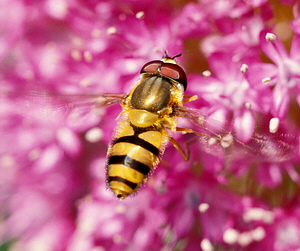 Epistrophe grossulariae
Epistrophe grossulariae
The weather this month is often beautiful, of course, and there are still plenty of opportunities to find hoverfly species that have so far evaded detection this year. Among these might well be the golden-haired Epistrophe grossulariae, a species which often keeps its wings vibrating as it touches down on a flower to feed. One of the very best places to hunt for hoverflies is ivy, many plants of which will now be in full flower. Straightforward to find should be various species of Eristalis and Syrphus, as well as Helophilus pendulus and the chunky greenish-gold Myathropa florea. However, a great prize is possible: the extremely rare Callicera spinolae favours ivy flowers in autumn. It was first discovered in eastern Bedfordshire as recently as 2010 and has appeared in most years since, apparently spreading west. Patches of ivy anywhere may attract it, including wood-edges, hedgerows, gardens and churchyards. Fittingly for such a rare creature, it stands out from the crowd, having long, angled antennae, clearly tipped with white, and golden bands of hairs across a shining abdomen.
October
Ivy is still flowering in the woods and in the garden Michaelmas Daisy is likely to be a major attraction to hoverflies. There may well be up to four species of Eristalis present, and it is a realistic challenge to identify them all without catching them. On the larger species, check the legs: E. tenax has black hind-legs, with a hairy thickening where the pollen-basket would be on a honeybee (another example of the fine mimicry displayed by this species). E. pertinax has pied hind legs, and they are rather slender. On the smaller species, E. arbustorum has a distinctive unmarked face, with a "thatch" of pale hairs: it has an oblong brown mark (or "stigma") on the leading edge of the wing. E. nemorum has a dark stripe down its face, and a short, rather square, stigma.
If the identification challenge still seems a bit steep, why not try photographing them? With lower temperatures and food rather concentrated, hoverflies are less easily disturbed, allowing a close approach. If you are an experienced photographer, you will know about macro lenses, the depth of field challenge and the problems of camera-shake at low shutter speeds. If you are not, grab a digital camera, go out and snap away as much as you can; it is surprising how many acceptable pictures will result, and certainly some will be good enough to identify tricky species. You can easily keep the better shots, and delete the others, making room again on your memory card. Of course, you can also share your pictures with others, checking identifications and submitting your records at the same time.
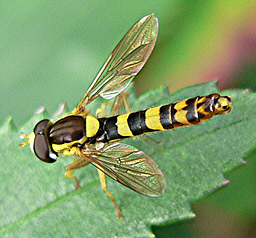 Sphaerophoria scripta
Sphaerophoria scripta
November
At the beginning of the month, in a normal year, there may well be eight or ten species of hoverfly still to be seen, with flowers as ever being the best place to look. Among them will be the last of the summer species, such as Sphaerophoria scripta, the males of which are distinguished by a very long abdomen that stretches beyond the closed wing-tips, as well as the commoner Platycheirus and Syrphus species. The last fly of the black-and-yellow genus Eupeodes is likely to be seen about now, and will probably be E. luniger.
As with migrant birds, it is always more of a challenge to record the last individual than the first, so, as often in the year, it is worth making a written note of what hoverflies you see as you see them: you will then easily be able to determine when individual species have dropped out.
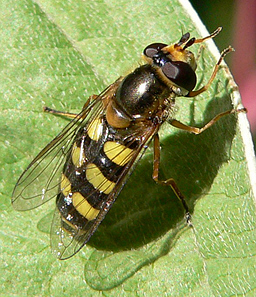 Eupeodes luniger
Eupeodes luniger
December
There are now very few flowers still blooming in the countryside, though the occasional fresh hogweed (always a good plant for hoverflies) is a welcome exception, and still merits checking for late individuals. In the garden, whatever colour remains will on sunny days be visited by the tough customers preparing to go through the winter. If you've been watching since January, it will come as no surprise to you that Marmalade and Drone are the most likely to put in an appearance. It would be an interesting exercise to check each individual and note its sex: this is easy enough as, in both species, the eyes of males touch on the top of the head, those of females do not. Supposedly, more females survive the winter than males, but is this true, and if so, what are the differences in proportion between the sexes?
If you don't know what Christmas present to ask for, you could ask someone to buy you a book about hoverflies, or spend a gift token or some cash on one (Here are some suggestions). Other presents for the hoverfly enthusiast might include a hand-lens for close-up views, a nest of clear-bottomed card boxes, or a butterfly net (a white one is best for flies, and dark insects in general). Suppliers of these, and other items of gear, include Watkins and Doncaster, Anglian Lepidopterist Supplies, and NHBS; all have helpful websites.
If you haven't done so already, now may be a convenient time to get together your wildlife records for the year and send them to the relevant County Recorders: the Hoverfly Recorder would certainly be delighted to receive any records you have even of the commonest species. Why not do it over the holiday: it makes a break from the Christmas telly, and will call to mind summer days, both gone and to come. A Merry Christmas and a Happy New Year to you all!
Bedfordshire County Hoverfly Recorder
images © John O'Sullivan & Keith Balmer